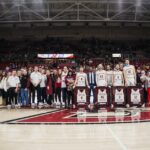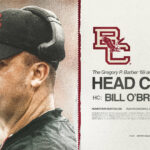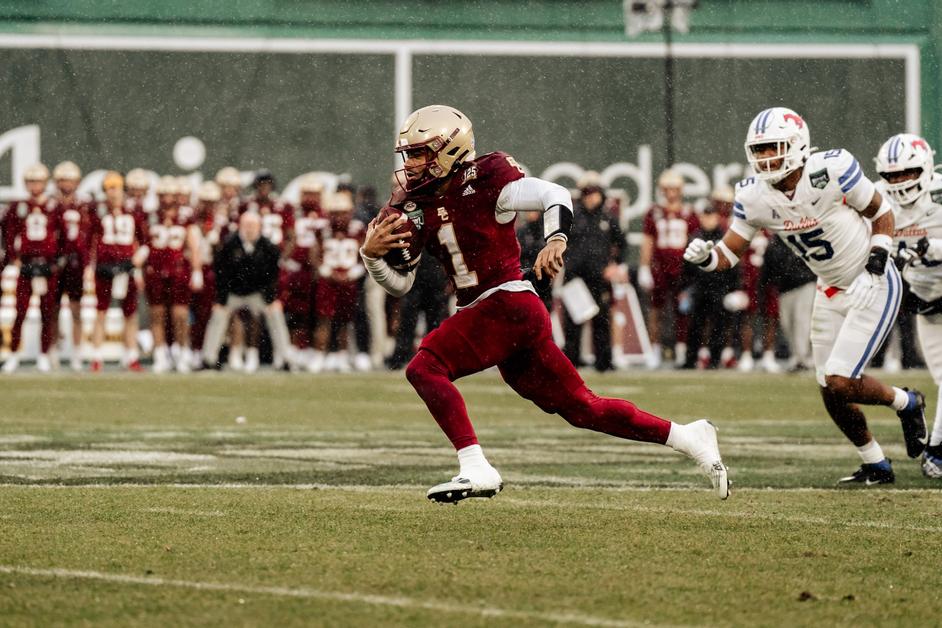Thomas Castellanos stood alone in the middle of the locker room in the aftermath of Boston College’s 23-14 win in the Wasabi Fenway Bowl last week. The outpouring of a raucous celebration continuously exploded around him, but the impromptu dance circle somehow managed to draw attention to the one player who wasn’t showing off any moves. The centerpiece of the offense, he instead stood with a smile as his teammates held down the dance floor, a pair of sunglasses on his face and a silver baseball bat in his hand.
Four months earlier, Castellanos had been mired as the second-string quarterback on BC’s depth chart, but his performance against the Mustangs left little doubt about his now-entrenched status as the Eagles’ top option. The game somehow stamped his progress by calling back to almost every performance, and any remaining preconceived notions about his ability were quickly replaced by a clutch performance by a quarterback now ready to lead his team into its next era.
“To end the season like that, with a bowl win over a ranked team like [SMU], when really nobody gave us a chance – let’s be honest – it’s special,” said head coach Jeff Hafley. “It will build momentum for the guys that will be back and the right way to send off some seniors.”
Quarterbacks at Boston College used to follow a particular formula based on the Eagles’ ongoing identity as a power football team. Running backs and offensive linemen carried the majority of the water over the years, and an endless thread of hard-nosed wins defined the early start to the 21st century after players like Justice Smith, David Green, William Green, Derrick Knight, Montel Harris, and AJ Dillon eviscerated defenses behind the horsepower blocking of future NFL first-round picks.
Eight of the top ten career rushers in the BC record books played during the program’s Big East and ACC era, and the top five runners passed the torch from one era to another after Mike Cloud’s 3,597 yards moved to Knight’s 3,725, which in turn moved to Harris’ 3,735 and Andre Williams’ 3,739 before Dillon eclipsed them all as the programs first 4,000-yard runner.
Quarterbacks, in contrast, never reached the heights of either Doug Flutie or Glenn Foley until Matt Ryan became the first player to ever eclipse 4,000 yards passing in a single season. He joined the duo as the only players with 9,000 career passing yards, but aside from Chase Rettig’s 8,263 yards, no other quarterback in program history hit a 6,000 ceiling.
Such were the numbers that even Anthony Brown and Phil Jurkovec, the two full-time quarterbacks before Castellanos, finished their careers in the top 10 despite only injury woes limiting them to one full season. Both threw for more passing yards than Matt Hasselbeck, one of the program’s all-time premier throwers, but both had 1,000-yard backs, with Brown also throwing behind Dillon’s full-steam rushing attempts. None of this was a knock against anyone, but public opinion just widely accepted that BC won when the formula of an “O-Line U” built a running game for bruising and speedy backs.
Even after this year’s team entered the season looking remarkably similar to the previous method, but a quarterback swap against Northern Illinois ultimately failed when BC lost its opening game in overtime. Hafley in turn decided to install Castellanos as the regular starter for Holy Cross, but it further required the Eagles to redefine an offense originally built for a more traditional pocket passer in Emmett Morehead. New plays built around Castellanos’ skill set emerged, but growing pains remained until the second-half rally and near-upset over Florida State.
Changing the playbook on the fly required BC to walk a fine line between its past and future, and having Morehead as the second-string quarterback meant the Eagles retained a bit of their traditional package until Castellanos won five straight games as a starter. Even then, a couple of injury spots forced Hafley to dust off Morehead’s packages, but the transfer’s rise essentially forced those plays to become fewer and further spaced on the call sheet.
The culmination of the entire growth process occurred in a bowl game where Castellanos became the second quarterback to ever rush for 1,000 yards in a season. His first half required him to run as the team’s primary option, but a second-half switch to a pass-based game confused the Mustangs’ defensive backfield. Castellanos still used his legs to score two touchdowns, but he went 8-for-11 for 96 yards passing after halftime and pushed BC near the 250-yard mark for its combined efforts in the third and fourth quarters.
He finished the game with seven different explosive running plays, including the two touchdowns, and his 15-yard pass to Jaedn Skeete broke into a 32-yard gain during the late third-quarter rally. He didn’t miss on consecutive passes after throwing four straight incompletions in the first quarter, and the entire bulk of the second-half performance followed an admittedly bad interception to start the third.
“We got beat by a team that just played better than us,” said SMU head coach Rhett Lashlee. “There were times when we contained [Castellanos] and times we didn’t, and then you look and he runs for 156 yards. I think he made big plays when they needed it, and we didn’t have an edge on our defense on his late touchdown run. In the first half, there were a couple of scrambles where he did what he’s good at. He extends plays, he’s really hard to get on the ground, and that’s tough on any defense.”
The performance set Castellanos apart from any other quarterback that’s ever played for the Eagles, and he holds the rare distinction of being the one true dual-threat quarterback during an era that’s much more wide-open at the position. It’s unfair to look at his numbers as being more than Doug Flutie, Matt Ryan, or anyone else, but it’s also impossible to compare him to Tyler Murphy, the only other quarterback with 1,000 yards rushing in a single season and a player who ran an option-run offense.
This is almost heading into uncharted waters for BC’s program, but a full offseason offers tantalizing possibilities for a player who threatened to break into the top 10 for both the single-season passing and rushing yard totals. It’s a new day, and from the Fenway Bowl, a significant launchpad exists for the Eagles to rebuild and redefine their team around their quarterback, who conceivably could add more hardware than just a silver baseball bat as a bowl game MVP.
“[The improvements] were a big emphasis with Thomas and the wideouts,” Hafley said during the bowl’s practice weeks. “We had a couple of weeks to really emphasize spending more time throwing to them, so I’ve really liked how he’s thrown the ball. It’s probably as good as I’ve seen him throw it, which is not just good for a bowl game. To me, it’s good going forward into the winter and in the spring.”
Author Profile
Latest entries
 Radio ShowsApril 25, 2024BC Baseball: 12th Annual ALS Awareness Game Kicks Off Series Against No. 14 UVA
Radio ShowsApril 25, 2024BC Baseball: 12th Annual ALS Awareness Game Kicks Off Series Against No. 14 UVA ACCMarch 14, 2024BC to Play 12th Annual ALS Awareness Game at Fenway Park
ACCMarch 14, 2024BC to Play 12th Annual ALS Awareness Game at Fenway Park ACCMarch 3, 2024Eagles Fall in Home Finale to Pittsburgh
ACCMarch 3, 2024Eagles Fall in Home Finale to Pittsburgh ACCFebruary 10, 2024Boston College Names Bill O’Brien Head Football Coach
ACCFebruary 10, 2024Boston College Names Bill O’Brien Head Football Coach

